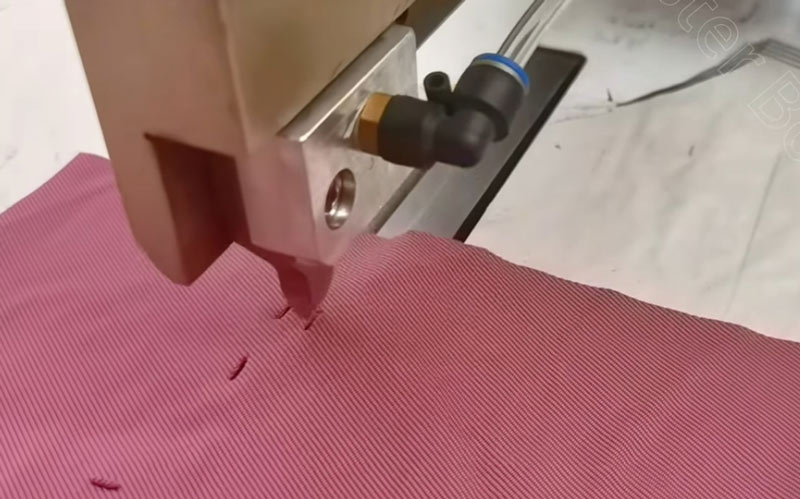In today’s fast-paced and innovation-driven manufacturing industry, the demand for clean, efficient, and precision-based processing technologies is constantly growing. Among various advanced technologies, ultrasonic punching machines have emerged as one of the most promising and versatile solutions, especially in fields such as textiles, medical equipment, packaging, electronics, and automotive components.
Unlike conventional mechanical or laser punching methods, ultrasonic punching delivers high-precision results without generating smoke, burrs, or deformation. It’s particularly effective for delicate or flexible materials like synthetic textiles, non-woven fabrics, thermoplastics, and multi-layer laminates.
This article provides a comprehensive overview of ultrasonic punching machines—exploring their working principles, structural design, key advantages, and real-world applications across industries.
1. What is an Ultrasonic Punching Machine?
An ultrasonic punching machine uses high-frequency mechanical vibrations to perforate, seal, or shape materials without direct blade contact or thermal degradation. It is a non-contact, friction-based process that leverages localized heat generated by ultrasonic vibrations to melt and puncture materials precisely.
1.1 Working Principle
A generator converts electrical energy into high-frequency (typically 20–40 kHz) signals.
These signals are fed into a transducer, which transforms them into mechanical vibrations.
The vibrations are amplified by a booster and transmitted to a horn (sonotrode).
When the horn contacts the workpiece with pressure, high-frequency frictional energy is concentrated on a small area.
The material softens and melts locally, enabling precise punching or trimming.
This process does not require external heat sources, adhesives, or additional consumables, making it both energy-efficient and environmentally friendly.
2. Components of an Ultrasonic Punching Machine
An ultrasonic punching system typically consists of the following components:
| Component | Function |
|---|---|
| Ultrasonic Generator | Produces high-frequency electric signals. |
| Transducer | Converts electric signals into mechanical vibrations. |
| Booster | Amplifies the amplitude of the vibrations. |
| Horn (Sonotrode) | Transfers the vibrations to the workpiece and performs punching. |
| Die / Anvil | Acts as a base mold for shaping and punching the material. |
| Control System | Manages parameters like amplitude, duration, and pressure. |
Some advanced systems also include automated feeding, optical recognition, programmable motion control, and user-friendly interfaces for real-time adjustments.
3. Advantages of Ultrasonic Punching
Compared to mechanical die punching or laser cutting, ultrasonic punching machines offer several standout benefits:
3.1 Clean, Burr-Free Processing
There’s no burning, melting residue, or carbonization. This is ideal for industries with strict cleanliness standards like medical, hygiene, and food packaging.
3.2 High-Speed, Continuous Operation
Ultrasonic punching can operate at line speeds up to several meters per minute, greatly improving productivity in high-volume manufacturing environments.
3.3 No Tool Wear or Downtime
Since there is no physical cutting edge, there’s minimal tool wear. This reduces maintenance costs and increases machine lifespan.
3.4 Smooth, Sealed Edges
The punched holes or shapes have smooth, sealed edges. This is especially useful for synthetic fabrics where fraying or unraveling is a concern.
3.5 Customizable and Versatile
By changing the horn shape or die configuration, a wide variety of patterns, sizes, and functions can be achieved. This makes the system suitable for both standardized and highly customized production lines.
4. Key Industrial Applications
Ultrasonic punching machines are revolutionizing manufacturing in the following sectors:
4.1 Seamless Apparel and Textile Industry
With the rise of seamless garments, ultrasonic punching offers a fast and effective way to punch breathable holes, cut patterns, or create decorative effects without sewing.
Typical Use Cases:
Seamless POLO shirt plackets: Clean, precise openings with no sewing or laser carbonization.
Sportswear mesh ventilation: Micro-perforations for breathability in synthetic fabrics.
Underwear and lingerie: Gentle punching and edge sealing in delicate fabrics.
Decorative holes in lace or trims: Consistent patterns with enhanced edge stability.
Alster, as a manufacturer of ultrasonic machines and seamless garment solutions, has successfully helped apparel brands upgrade from traditional sewing or laser methods to fully integrated ultrasonic punching systems.
4.2 Automotive Interiors
Car interiors contain a wide range of synthetic and foam materials that require clean, precise holes or patterns. Ultrasonic punching enables aesthetic design and functional perforation with superior edge quality.
Typical Use Cases:
Door panel decorative perforations
Seat ventilation hole punching
Dashboard sound-absorbing fabric micro-perforations
Roof liner punching for improved air circulation
Ultrasonic punching ensures uniform hole sizes, reduces VOC emissions, and avoids thermal damage to synthetic automotive textiles.
4.3 Medical and Hygiene Products
Hygienic and sterile manufacturing is essential in the medical industry. Ultrasonic punching allows clean perforation without using needles or heat, which may introduce contaminants.
Typical Use Cases:
Surgical masks: Hole punching for breathing valves
Isolation gowns: Armpit ventilation holes
Wound dressings: Perforated non-woven absorbent layers
Sanitary pads and diapers: Perforations for fluid control and comfort
These operations benefit from the non-invasive, sterile processing made possible by ultrasonic punching.
4.4 Packaging and Filtration Industries
Whether for food safety, ventilation, or material separation, many packaging and filtration applications require precise micro-holes.
Typical Use Cases:
Coffee capsule air vent punching
Vacuum-sealed bags with pressure relief holes
Multilayer film perforation for breathability
Filter media and dust bags with functional holes
Unlike traditional punching or burning, ultrasonic punching maintains material integrity and does not leave smoke or char.
4.5 Electronics and Solar Energy
As electronics shrink and require greater precision, ultrasonic punching provides the accuracy needed for film, foil, and circuit layer processing.
Typical Use Cases:
Touch screen PET film hole punching
Flexible circuit board alignment holes
Solar cell encapsulation films
Insulation layers in battery modules
This level of precision is critical to avoid electrical failure or insulation breakdown.

5. Future Trends in Ultrasonic Punching
As demand increases for flexible, digital, and green manufacturing, ultrasonic punching is evolving in several key directions:
5.1 All-in-One Smart Machines
Future machines will combine punching, trimming, sealing, embossing, and welding into a single intelligent platform, reducing factory footprint and increasing versatility.
5.2 Advanced Motion and AI Integration
With the integration of vision systems and AI, machines will offer real-time defect detection, automatic adjustment, and adaptive control, minimizing waste and improving accuracy.
5.3 Micro-Punching for Medical and Electronics
Technological advances will enable sub-millimeter or even micron-level punching for microfluidics, lab-on-a-chip devices, and next-gen batteries.
5.4 Green, Low-Energy Design
Ultrasonic systems are inherently low-energy. Innovations will further reduce power consumption, enhance acoustic efficiency, and improve sustainability through recyclable components and lower emissions.
6. Conclusion: A Cutting-Edge Solution for Precision Manufacturing
Ultrasonic punching machines represent a significant leap in modern manufacturing—offering unmatched precision, efficiency, and cleanliness. As manufacturers across industries move away from mechanical or laser systems, the adoption of ultrasonic technologies continues to accelerate.
With versatile applications in textiles, automotive interiors, healthcare, packaging, and beyond, ultrasonic punching machines are not just a trend—they are shaping the future of industrial production.
For manufacturers looking to stay ahead of the curve, adopting ultrasonic punching technology is not just an upgrade—it’s a strategic move.
If you’re seeking a trusted partner for high-performance ultrasonic punching solutions, Alster provides a full range of customizable ultrasonic machines designed to meet the specific needs of seamless garment manufacturers, medical suppliers, and packaging companies worldwide.
